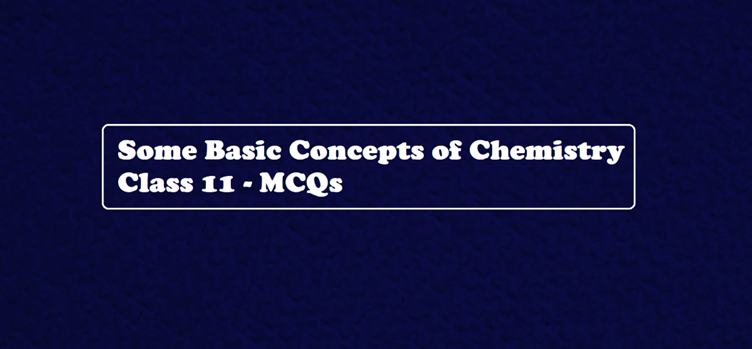Some Basic Concepts of Chemistry Class 11 -MCQs
Some Basic Concepts of Chemistry Class 11
1. If the measured temperature on the Fahrenheit scale is 200°F then the reading on the Celsius scale will be …….
(a) 40°C
(b) 94°C
(c) 93.3°C
(d) 30°C
2. Which one of the following data has only four significant figures?
(a) 6 023 × 1023
(b) 285 cm
(c) 0.0025 L
(d) 0.200 g
3. The number of significant figures in 10.3406 g is ……
(a) 2
(b) 3
(c) 1
(d) 6
4. The result of which of the following has/have the least significant figure(s)?
(a) 0.02856 × 298.15 × 0.112 /0.5785
(b) 5 × 5.364
(c) 0.0125 + 0.7864 + 0.0215
(d) All have same number of significant figures.
5. A refers to the closeness of various measurements for the same quantity. B is the agreement of a particular value to the true value of the result. A and B respectively are
(a) A→ significant figures→ accuracy
(b) A→ accuracy, B→ precision
(c) A→ precision, B→ accuracy
(d) A→ significant figures, B→ precision
6. The least count of an instrument is 0.01 cm. Taking all precautions, the most possible error in the measurement can be …….
(a) 0.005 cm
(b) 0.01 cm
(c) 0.0001 cm
(d) 0.1 cm
7. Which of the following statements about the molecular mass is correct?
(a) Molecular formula shows the exact number of different types of atoms present in a molecule.
(b) Molecular formula can be obtained from the empirical formula if the molar mass is known.
(c) Percentage composition of a compound can be calculated from its molecular formula.
(d) All the above statements are correct.
8. The percentage of nitrogen in urea is about
(a) 46
(b) 85
(c) 18
(d) 28
9. The weight of one molecule of a compound C60 H122 is …….
(a) 1.3 × 10-20 g
(b) 5.01 × 10−21 g
(c) 3.72 × 10−12 g
(d) 1.4 × 10−21 g
10. One mole of any substance contains 6.022 × 1023 atoms/molecules. What will be the number of molecules of H2SO4 present in 100 mL of 0.02 M H2SO4 solution?
(a) 12.044 × 1020 molecules
(b) 6.022 × 1023 molecules
(c) 1 × 1023 molecules
(d) 12.044 × 1023 molecules
11. The number of molecules in 18 mg of water in terms of Avogadro number, NA is
(a) 10−3 NA
(b) 10−2 NA
(c) 10−1 NA
(d) 10 NA
12. If 1 mL of water contains 20 drops then the number of molecules in one drop of water is …… molecules
(a) 6.023 × 1023
(b) 1.376 × 1026
(c) 1.344 × 1018
(d) 4.346 × 1020
13. In which case is the number of molecules of water maximum?
(a) 0.00224 L of water vapours at 1 atm and 273 K
(b) 0.18 g of water
(c) 18 mL of water
(d) 10−3 moles of water
14. The mass per cent of different elements present in sodium sulphate, (i.e., sodium, sulphur and oxygen) respectively are (NCERT Exemplar)
(a) 32.37; 45.06 and 22.57
(b) 22.57; 32.37 and 45.06
(c) 45.06; 32.37 and 40.06
(d) 32.37; 22.57 and 45.06
15. What is the mass per cent of carbon in carbon dioxide?
(a) 0.034%
(b) 27.27%
(c) 3.4%
(d) 28.7%
16. The empirical formula and molecular mass of a compound are CH2O and 180 g respectively. What will the molecular formula of the compound be?
(a) C9H18O9
(b) CH2O
(c) C6H12O6
(d) C2H4O2
17. An organic compound on analysis was found to contain 10.06% carbon, 0.84% hydrogen and 89.10% chlorine. What will be the empirical formula of the substance?
(a) CH2Cl2
(b) CHCl3
(c) CCl4
(d) CH3Cl
18. The stoichiometric ratio of sodium dihydrogen orthophosphate and sodium hydrogen orthophosphate required for the synthesis of Na5P3O10 is
(a) 1.5 : 3
(b) 3 : 1.5
(c) 1 : 1
(d) 2 : 3
19. The total number of gm-molecules of SO2Cl2 in 13.5g of sulphuryl chloride is [CPMT 1992]
(a) 0.1
(b) 0.2
(c) 0.3
(d) 0.4
20. A molar solution is one that contains one mole of a solute in [IIT 1986]
(a) 1000 g of the solvent
(b) One litre of the solvent
(c) One litre of the solution
(d) 22.4 litres of the solution
Some Basic Concepts of Chemistry Class 11
Read the assertion and reason carefully to mark the correct option out of the options given below:
(a) If both assertion and reason are true and the reason is the correct explanation of the assertion.
(b) If both assertion and reason are true but the reason is not the correct explanation of the assertion.
(c) If the assertion is true but the reason is false.
(d) If the assertion and reason both are false.
(e) If the assertion is false but the reason is true
21. Assertion: The volume of a gas is inversely proportional to the number of moles of a gas.
Reason: The ratio by volume of gaseous reactants and products is in agreement with their mole ratio. [AIIMS 1995]
22. Assertion: Molecular weight of oxygen is 16.
Reason: Atomic weight of oxygen is 16. [AIIMS 1996]
23. Assertion: Atoms can neither be created nor destroyed.
Reason: Under the similar condition of temperature and pressure, an equal volume of gases does not contain an equal number of atoms. [AIIMS 1994, 2002]
24. Assertion: One mole of SO2 contains double the number of molecules present in one mole of O2.
Reason: Molecular weight of SO2 is double to that of O2.
25. Assertion: 1.231 has three significant figures.
Reason: All numbers right to the decimal point are significant.
[pdfjs-viewer url=”https://sciencemotive.com/wp-content/uploads/2022/07/11assignment-1-Class-11-chapter-1-with-Answers.pdf” attachment_id=”4395″ viewer_width=100% viewer_height=800px fullscreen=true download=true print=true]
Some Basic Concepts of Chemistry Class 11



